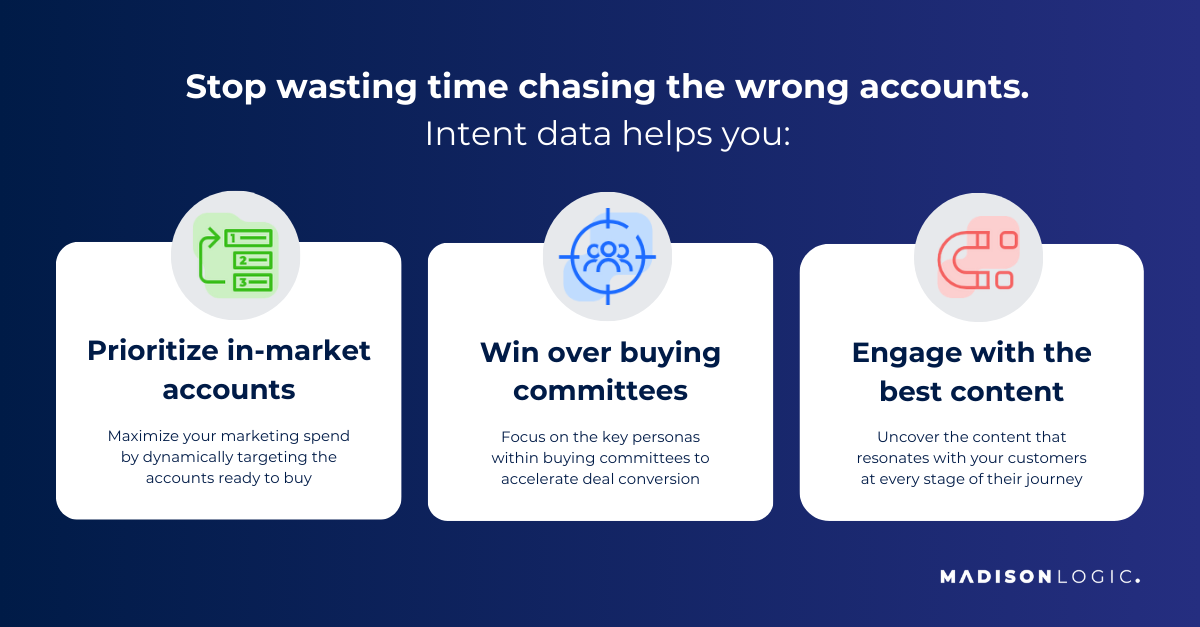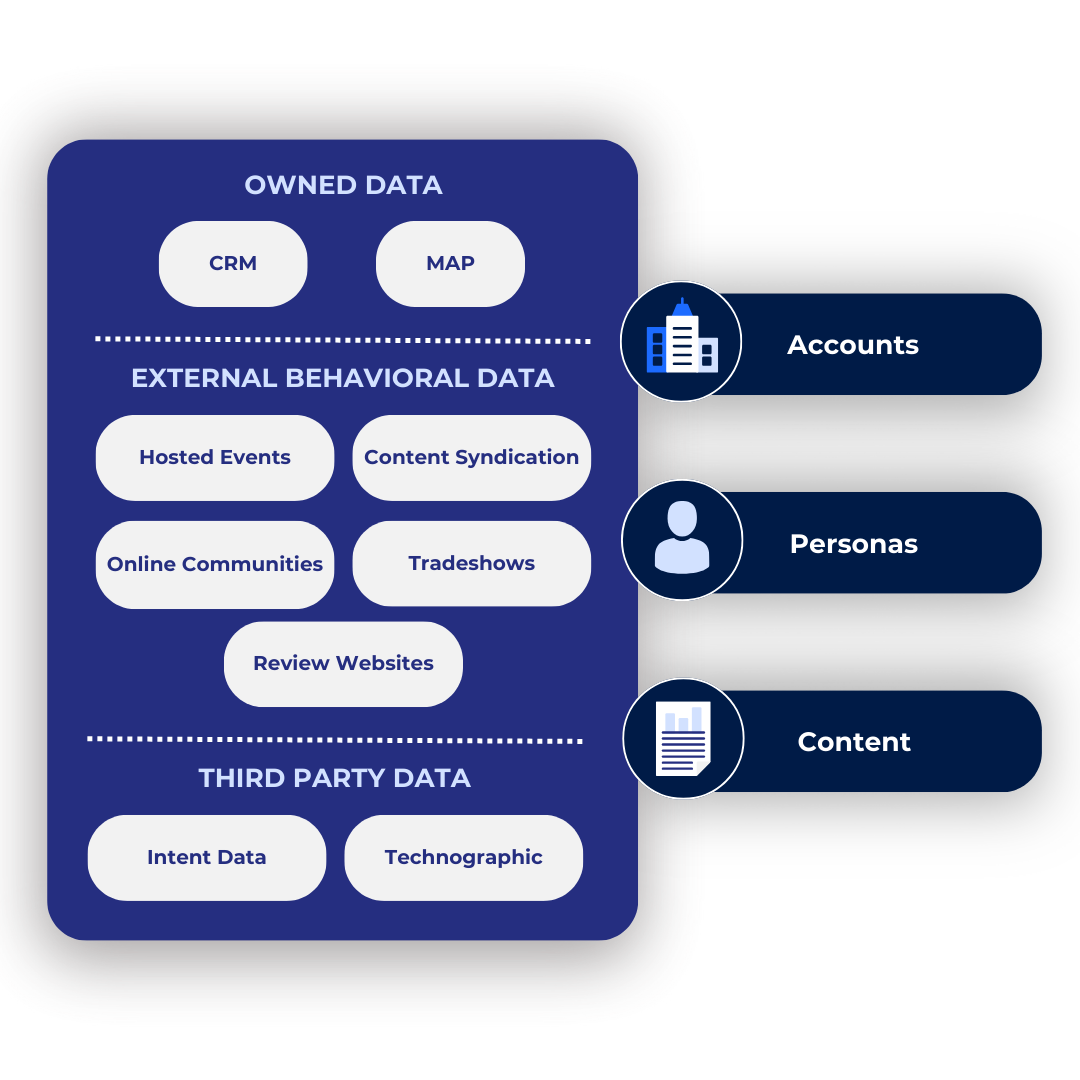
Your sale does not start with the first conversation between your sales team and the customer. It begins the moment your customer recognizes a problem or opportunity for their business. At this stage, however, they may not yet be ready to engage with you—they need time to research, evaluate options, and fully understand their needs before initiating a conversation.
According to FocusVision, the average B2B customer journey involves the buying committee consuming an average of 13 pieces of content, takes an average of two to six weeks, and involves three to four decision-makers.
Not all this time is spent talking to sales about solutions. That’s the smallest chunk of time in the B2B buying journey with only 17% of a buying group’s time dedicated to meeting with potential providers. Look at the graphic below from Gartner: most of the time spent by a B2B buying committee is away from solution providers. Within this time, they are using content and research to inform their decision to meet with a provider, so marketers need to be sure that buyers have the content they need to move forward in the buyer’s journey.

Instead of waiting for that first sales conversation, wouldn’t it be great to give this buying group the exact content they need to solve their problem in their research phases and lead them to your solution? And wouldn’t it be great to know more about your buyers so you can personalize and activate a great customer experience from start to finish?
You can when you use buyer intent data.
Intent Data Explained
Buyer intent data is a collection of signals that reveal when a prospective customer is looking for or interested in learning about a solution. These signals are combined to provide marketing and sales teams with intelligence on the organizations and key decision-makers interested in additional information about a solution as they perform in-market research. Armed with buyer intent data, B2B marketers and salespeople can know when an account is ready to buy and take immediate action to drive higher ROI.
For example, if an account is consuming content on “HR software,” the act of downloading the content asset or watching the virtual event is an early indicator that this organization may want to learn more about HR software. As a result, savvy marketers and sales teams can focus their efforts on the accounts that matter most by:
- Prioritizing in-market accounts
- Knowing which personas to engage across the buying committees
- And understanding what content is most likely to convert

Understanding the Different Types of Intent Data
Not all intent data is created equal.
Before leveraging intent data, it’s important to understand the different types of intent signals and the unique role each plays in how you approach your audience and campaigns.
There are three types of buyer intent data:
- Owned data (also known as first-party intent data)
- External behavioral data
- Third-party data
Let’s break down what each intent data source means, where they come from, and why they are important.
Owned Intent Data
Often referred to as first-party data, owned data is any data sourced directly from your own audience and customers. Owned data is valuable because it reflects direct interactions with your brand, giving you insights into customer behavior and preferences.
Here are some common methods for gathering it:
- Customer relationship management (CRM) platform
- Marketing automation platform (MAP)
- Download forms or newsletter signups
- Questionnaires
- Registration information for events
- Website visits and metrics about users
First-party data is typically bolstered with personally identifiable information (PII), like an email address or a user’s name. For example, if someone downloaded a white paper from your website, you can then collect their email address and follow up with targeted communications based on their interests. Owned data is crucial to your sales team when they start to reach out to prospective buyers and helps segment accounts into categories like:
- Net-new logos: Brand-new accounts who have not previously engaged with your business. By identifying net-new logos, your team can focus on outreach strategies to attract new prospects and expand your customer base.
- Expanding customers: Existing customers who are showing signs of growth or increased engagement. Understanding this segment allows your sales team to nurture and grow these relationships, potentially increasing their customer lifetime value (CLV).
- Cross-sell and upsell opportunities: By identifying cross-sell opportunities—where you introduce new products to existing customers—or upsell opportunities—where you offer enhanced versions of products they already use—your team can deliver tailored solutions that enhance customer satisfaction while also driving additional revenue.
External Behavioral Intent Data
External behavioral data is collected by partnering with trusted sources that share insights about their audiences. This can include interactions that have been purchased from other businesses, typically used with permission. For example, review sites like G2 Crowd offer their owned data (first-party data) for purchase that gives insight into which users have been viewing your profile or browsing products that you offer. Other examples of external behavioral data include hosted events, online communities, and tradeshows.
External behavioral data is valuable for providing insights that may not be visible from your owned data in itself. This additional insight helps paint a more complete picture of your audience’s behaviors and interests by giving you:
- Broader audience insights: Gain a more comprehensive understanding of your audience by accessing data from outside sources.
- Enhanced targeting: Use insights from external sources to refine your B2B buyer personalization and marketing strategies.
- Trust and transparency: This data is reliable because it comes from reputable trusted partners who share their owned data/ first-party data with your organization.
Third-Party Intent Data
Third-party intent data consists of information collected from external sources across the web, specifically from third-party sites outside of your organization. Third-party data provides a more comprehensive picture of an account’s online interests by tracking individual activity on platforms that are not part of your website or server. By leveraging this insight, you can better understand potential customer behaviors and interests beyond your owned or first-party data.
Third-party intent data can be collected through a variety of sources, including:
- Data providers: Intent data providers like ML Insights or Bombora offer high-quality data sets that help identify in-market accounts.
- Install base: Technographic data offering information on a company’s existing technology stack, ABM tools, and their current product usage.
- B2B research: Visibility into accounts that are consuming content and advertising relevant to your solution.
Let’s say, for example, someone is researching industry trends or comparing products across the web. Third-party intent data would reveal this behavior by tracking their activities on relevant websites and content platforms. Ultimately, third-party data is crucial for understanding your buyers, including those who may not be directly interacting with your brand.
Bonus: Firmographic Data
Although firmographic data isn’t a B2B intent signal on its own, it is often layered with intent data to enhance marketers understanding of target accounts and to build target account lists (TAL).
- Firmographic data: Firmographic data includes key attributes of a company, such as industry, company size, revenue, and location. This data helps you identify which organizations are the best fit for your offerings.
Layering your buying intent data with firmographic data provides a holistic view of your target accounts, allowing you to understand not just who they are, but also their buying behaviors. This comprehensive view enables you to tailor your messaging and outreach strategies, ultimately making your account-based marketing (ABM) plans more effective.

How Buyer Intent Data Is Collected
While each signal provides unique and valuable insights into your buyers, where does buyer intent data actually come from?
Internal Sources
Owned intent data (first-party intent) is collected by your organization with website tracking, visitor analytics, form fills, and content downloads. Owned data is considered “directed” intent signals because they are unique to you and your organization and can’t be acquired by another company. Owned intent data can be highly predictive of purchase intent because it reveals specific behaviors and interests demonstrated by users directly interacting with your brand, indicating their readiness to engage in the buying process.
External Sources
Unlike owned data, both external behavioral data and third-party data originate from external sources outside your organization.
External behavioral data is gathered from interactions with trusted partners who share insights about their audiences’ activities, typically purchased or acquired with permission. This data can include engagement from review platforms, industry blogs, or partner websites, giving you a view of potential customers’ activities beyond your direct reach.
Third-party intent data originates from platforms that track online research activity and behavioral signals from partners like ML Insights, media publishers, B2B websites, social media, and other sources. By using IP-address tracking, company mapping, and third-party cookies (even with recent updates from Google that indicate more organizations should pivot to cookieless marketing), intent data providers can monitor keyword searches and topics that relate to an industry or solution. Intent data providers create baselines for content consumption and engagement for each topic or company, and report on spikes that indicate the likelihood that an account researching this topic is in the market for a solution.
5 Benefits of Using a Combination of Intent Data for Your ABM Campaigns
Owned data, external behavioral data, and third-party data each offer unique benefits. However, their full potential is realized when combined, providing a complete view of your account data.
The best marketers combine all three data sources to guide their ABM campaigns, creating a more comprehensive and accurate picture of their target accounts, including insight on:
- Who to target
- What content and nurture programs individuals need to progress through the buying stages
- When in the buyer’s journey specific messaging should be delivered
- Where and on what channel buyers prefer to access this information
- Why buyers are engaging with your brand
With research from Gartner revealing that 62% of companies use one or more intent data solutions, it’s clear that intent data is becoming increasingly important among marketers.
With that in mind, here are five compelling benefits of using intent data in your ABM campaigns:
1. Stronger Sales and Marketing Alignment
B2B sales and marketing teams share a common goal: revenue. However, achieving that goal requires alignment between the two teams. Intent data bridges the gap between marketing and sales teams, helping to optimize ABM engagement tactics and messaging.
Intent data helps marketers by revealing which prospects are actively researching products and reveals where the buying stage key decision-makers are in, enabling tailored, relevant outreach. When both marketing and sales teams use this data to align on messaging, timing, and channels, they create a seamless experience for prospects—allowing marketing to deliver more successful account-based marketing campaigns and sales to ensure a more unified and seamless buying experience.
2. Identify Buying Committee Members Not on Your Radar
Effective ABM campaigns surround and engage all members of the buying committee to create a unanimous decision to purchase your solution. Your content needs to speak to buying-committee members you’re unaware of—the ones who haven’t submitted a form for content but may be getting links and intel from the person who is advocating for your product.
Remember: While content ideally educates, motivates, and persuades readers to meet with your sales team, you still need to anticipate any blockers. Blockers may be stakeholders who are skeptical, resistant, or simply have concerns about your proposed solution. They might hold decision-making authority or sway over the buying committee’s decisions. When you have a clearer sense of who else is part of the buying committee using intent data, you are more likely to target blockers and product champions at a granular level to address their concerns.
This includes:
- Messaging: Craft outreach that speaks directly to their individual and often unique interests and needs.
- Content: Provide resources such as white papers, ROI calculators, and social proof that aligns with the concerns these buyers have to demonstrate how your solution solves for it.
- Preferred Channels: Reach blockers on the channels where they’re most active.
Using intent to tailor messaging, content, and outreach to these buyers’ preferences and needs ultimately increases the chances of capturing their interest.
3. Shorten Sales Cycles
It can take about seven months on average to close a B2B deal. The longer an account stays in the sales cycle, the more time it has to change its mind or find an alternate solution.
Luckily, when you use intent data in ABM, you can create a personalized and targeted experience for a buyer that will lead them to where they need to be—in your sales pipeline—faster. By revealing which accounts are actively researching specific topics, marketers can use intent data insights to deliver valuable content at precisely the right moments, leading prospects through the sales funnel more effectively. For example, if you know that an account is engaging with content on data security, a targeted white paper on the latest data protection solutions could help move them forward faster.
4. Get Rid of Random Acts of Marketing
What are random acts of marketing, and why are they bad for your brand?
According to Karen Hayward, author of Stop Random Acts of Marketing: Deliberate & Practical Growth Strategies for Mid-Market CEOs, random acts of marketing are tactics that get deployed without rhyme or reason and are not tied to strategy. This helps no one, and marketers can see depleted budgets and lower ROI numbers when they commit random acts of marketing.
As we like to say, marketing isn’t magic, it’s logic. Fortunately, intent data works to eliminate any magical guesswork and prevents these random acts. By providing insights into buyer behavior and engagement, intent data allows marketers to better understand their target audience. Armed with this information, you can craft a content strategy and messaging that align with buyer needs, ensuring that your marketing efforts are purposeful and impactful. This not only reduces wasted marketing spend but also drives higher ROI by reaching buyers with relevant content at the right time.
5. Transform Dream Accounts into True Prospects
A good marketer can identify “who to target” by building their ideal customer profiles (ICP), but a great marketer is able to use data to narrow this down by instead asking, “Who should we target and how?”
It’s important to determine your campaign audiences based on data, not your gut. Start by looking at the types of accounts you want as customers—your ICP—and the specific buyers or decision-makers within these accounts that you’ll be targeting.
But remember that ICPs and buyer personas are just educated guesses.
By layering intent data onto your ICP and buyer personas, you can pinpoint exactly “who to target and how” with greater precision by identifying in-market accounts and the buyer personas within those accounts who are most engaged. This allows you to target the right prospects across the buying committee and deliver content and messaging that resonate—ultimately leading to sales meetings, turning those ideal accounts into closed-won deals and maximizing the impact of your ABM efforts.
Use Cases for Buyer Intent Data
Data and logic should fuel every step of your marketing and account-based strategies. B2B intent data delivers exactly that, allowing B2B marketers to:
- Target with precision: Intent data helps you identify which prospects are actively researching solutions, enabling you to remove guesswork and focus on high-intent accounts that are more likely to convert.
- Personalize outreach: By understanding the specific interests and behaviors of potential buyers, you can tailor your messaging and content to resonate with buyer needs and pain points.
- Optimize resources: With insights from intent data, you can prioritize their resources more effectively, ensuring that campaigns are directed toward the account most likely to convert.
With its ability to sharpen targeting and personalize outreach, it’s clear why B2B marketers are embracing intent data. According to a 2020 Forrester survey, 77% of B2B marketers are using intent data in their ABM programs, with 11% making plans to implement it in their future ABM campaigns.
So, how can you make the most of intent data in your own strategy? Let’s dive into practical use cases to put your B2B intent data to work.
Content Marketing
B2B buyers increasingly expect personalized experiences from brands. If you’re not delivering the right content built for your buyers’ specific concerns, needs, and interests when and where they need it, there’s a good chance key decision-makers won’t see it or engage.
Buyer intent data has many applications in ABM content marketing, including:
- Identifying and prioritize the key personas within buying committees to influence decision making.
- Align your content with the trending topics your target customers are researching.
- Build in-depth experiences by tailoring content to specific funnel stages
When your ABM content strategy is suited to the buyer’s needs and answers their questions before they ask you directly, they turn into better qualified leads, which you can hand over to your sales reps with more confidence that they can help convert leads into more wins and revenue.
Campaign Activation
As you develop a multi-channel ABM strategy, leverage intent data insights to proactively distribute content and messaging across the four key channels where buying committee members are most active:
Keep in mind that not all buyer personas progress through the funnel at the same rate. One decision-maker can still be in the awareness stage while everyone else has moved onto the consider stage. Use intent data to identify where each buyer is and to signal when they have moved to a new stage. By aligning intent-driven insights with your marketing mix channel strategy, you can tailor each message to match your audience’s specific needs and the stage they’re in, maximizing the impact of each touchpoint.
Sales Enablement
Forty percent of sales reps say prospecting accounts are the most challenging part of the sales process. Since the average B2B buyer is 67% through the buying journey before they engage with your sales team, it’s up to marketing to guide them through the funnel to the closed-deal finish line. Buyer intent data helps inform your revenue team outreach and conversations.
For instance, Madison Logic’s integration with Gong offers sales more visibility into the account journey, buying committee engagement, and trending topics to improve the quality of their interactions and help close deals faster.
Customer Success and Retention
Unless you have the secret to keeping customers forever, organizations should always be focusing on customer success and retention. Unlike customer support, which is a reactive function, customer success is proactive and ongoing to keep customers happy. The greatest threat is customer churn, which is always possible with so many other solutions available in the market.
Preventing churn is all about understanding your customers and looking for early warning signs that they may be looking somewhere else. While your customer success teams should be proactively checking in with customers regularly, buyer intent data should also be used to indicate if they’re actively researching other solutions.
Intent data can also be used to identify accounts for expansion campaigns. For cross-sell opportunities, keep an eye on customer intent, technologic, firmographic, and engagement data to dig deeper into understanding customers’ growth potential. One example is the technographic alignment between Salesforce and HubSpot. If HubSpot were to notice a growth in Salesforce activity—independent from using the HubSpot integration in Salesforce—then they would prepare to educate the customer about their Salesforce integration.
Is B2B Intent Data Worth the Investment?
So, is intent data really worth the investment for B2B marketers? Given its numerous benefits and use cases, we believe the answer is a clear yes.
But don’t just take our word for it. Here are some compelling stats demonstrating intent data’s effectiveness, and real results and case studies achieved by marketing leaders who have invested in it to power their best account-based marketing campaigns.
Intent Data Stats
- 96% of B2B marketers have seen success when using intent data to achieve their associated goals.
- 91% of marketers say they’re using intent data/scoring within ABM to prioritize their accounts.
- 97% of B2B marketers believe that intent data gives brands a competitive advantage.
Intent Data Results
- By leveraging ML Insights intent data, not only did Endava experience 40% of their top-of-funnel contacts come into their pipeline, but they’ve also seen 30X ROI on its influenced pipeline.
- Through ML Insights intent data, the Shell Lubricant Solutions team saw an expansion of its marketing and sales alignment and collaboration, leading to a more focused and effective targeting strategy.
- The team at Flexential credits ML Insights intent data for helping them see an increase of 22% in registrations, website traffic, and leads and a 25% increase in conversations. In addition to leveraging data to identify and target in-market accounts, the integration with the team’s marketing automation platform (MAP) has been a true game changer.

Make the Most of Your Intent Data with Madison Logic
Buyer intent data can give you a boost to knowing who your prospective buyers are before they even reach out to your sales team. Since the B2B buying journey is typically a long process, you can receive tons of revealing information about your prospective buyers by collecting intent data as they move through the buyer’s journey. Simply put, investment in intent data pays off in stronger overall marketing and sales performance by knowing your buyer before they make that first sales call.
Madison Logic’s industry-leading buyer intent data, ML Insights, pulls real-time intent data from over 20 million companies worldwide to reveal the content and media your target accounts and personas actively engage with the most. Accounts are scored in real-time to accurately predict when they are moving in-market.
Want a preview into ML Insight’s capabilities? Download our ABM Buyer Intent Guides for access to data-driven ABM insights about in-market accounts, buying group personas, and the content topics most likely to convert.
Or, request a demo to learn more!


